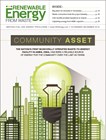Pictured, from left: Audrey Templeton of MillerCoors, Aaron Garcia of Cemex, Kristin Smith of REW magazine and Jeff Wooster of Dow.
The circular economy makes environmental and business sense as a number of companies illustrated during the session “Smart Business – A Look at Industrial Applications for RDF and Waste Conversion” during the 2015 Renewable Energy from Waste Conference, hosted by Renewable Energy from Waste magazine and GBB Inc. Nov. 16-19 in Orlando, Florida.
One of the principles of the circular economy involves the use of systems that maximize the use of biobased materials, extracting biochemical feedstocks and transitioning them into different, increasingly low-grade applications, according to the Ellen MacArthur Foundation. With the help of waste conversion, companies like MillerCoors, CEMEX and Dow are embracing this philosophy.
Audrey Templeton, corporate environmental manager for MillerCoors, headquartered in Chicago, said Miller and Coors used their merger in 2008 as an opportunity to hit the reset button, bringing their best practices together as a single corporation.
“Part of being the best beer company in American is being responsible,” she said.
The company set environmental goals that included reducing the amount of waste it sent to landfill by 15 percent. “We did a whole lot better than that,” Templeton said, adding that seven of the company’s eight major breweries are now landfill free. In 2008, MillerCoors sent more than 9,000 tons of waste to landfill. By 2015, that amount has been reduced to roughly 500 tons.
The company did not begin incorporating waste to energy as part of its waste management approach until 2011. Today, MillerCoors sends one shipment to the waste-to-energy facility each month, while in 2008 it had multiple truckloads of material heading to the landfill each week, Templeton said.
MillerCoors reduces waste by engaging employees and through creative partnerships, she said.
The company’s Golden, Colorado, brewery has been landfill free since 2013. Templeton said this was achieved in part through a solid system that incorporates balers and recycling stations that use appropriate collection containers close to the point of generation.
She added that the company’s use of WTE continues to decline as it continues on its quest toward zero waste.
Aaron Garcia of cement company CEMEX, with U.S. headquarters in Houston, said cement manufacturing is an energy-intensive process using rotary kilns filed with primary and alternative fuels. However, the company shies away from the term RDF (refused-derived fuel), preferring SRF (specified recovered fuel) instead because it implies a specific heat value.
According to the CEMEX USA website, “Our area mission is to produce cement, aggregates, concrete and other related building materials that will satisfy the highest global safety standards while having the least possible environmental impact.”
Garcia said CEMEX uses alternative fuels to save fossil fuels for future generations, to reduce its carbon footprint and to save landfill space. Additionally, the use of SRF has better prepared the company for upcoming environmental regulations, he said.
“We are a perfect solution,” Garcia said, noting that the ash from its furnaces becomes clinker that the company blends with gypsum to produce its product.
Garcia said alternative fuel accounts for 25 percent of its energy consumption, including 225,000 tons of biomass and 166,000 tons of tire-derived fuel. “The next big thing is going into plastics and paper,” he added.
He added that CEMEX does not consider its kilns incinerators, adding that the company prefers to work with suppliers that have comfort letters from the Environmental Protection Agency.
“Shredding is not enough to say you have an alternative fuel,” Garcia said, adding that chlorine is not welcome. CEMEX seeks Low-moisture material with high Btu, he added.
Jeff Wooster, global sustainability director for Dow Packaging and Specialty Plastics, said Dow envisions a more circular economy with the goal of improving resource efficiency. “We don’t want plastic packaging to end up in the landfill.”
He spoke about the company’s Energy Bag pilot project, which used purple bags to divert nonrecyclable plastic packaging from the landfill. The project ran from June 1 to Aug. 31, 2015, in Citrus Heights, California, and converted these nonrecyclable plastics into synthetic fuel oil. Residents were told, “If you can’t bin it, bag it.”
He said the purple bags were used so they would be easy to remove from the recycling stream. Wooster estimated that 25 pounds of flexible packaging are generated per household annually. Through the Energy Bag pilot, the company found that 13 bags of recovered packaging yielded 1 gallon of fuel.
“For the future of plastics, we have to make better use of capturing the value of these materials,” Wooster said.
Contamination in the Energy Bags averaged 14 percent, he said, adding that that was on par with the degree of contamination seen in the city’s curbside collection program. This contamination was primarily paper, though some food waste also was present, Wooster said.
Dow made the Energy Bags somewhat stronger than an average trash bag so it wouldn’t break and increase contamination at the material recovery facility, he added, noting that the breakage rate was less than 1 percent.
The Renewable Energy from Waste Conference was organized by Renewable Energy from Waste magazine, a publication of the Recycling Today Media Group, Valley View, Ohio, and GBB, Fairfax, Virginia. The event was at the Caribe Royale in Orlando.


